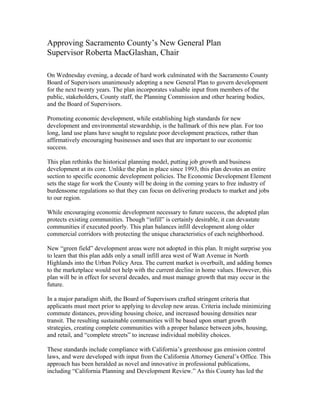MacGlashan General Plan
- 1. Approving Sacramento Countyâs New General Plan Supervisor Roberta MacGlashan, Chair On Wednesday evening, a decade of hard work culminated with the Sacramento County Board of Supervisors unanimously adopting a new General Plan to govern development for the next twenty years. The plan incorporates valuable input from members of the public, stakeholders, County staff, the Planning Commission and other hearing bodies, and the Board of Supervisors. Promoting economic development, while establishing high standards for new development and environmental stewardship, is the hallmark of this new plan. For too long, land use plans have sought to regulate poor development practices, rather than affirmatively encouraging businesses and uses that are important to our economic success. This plan rethinks the historical planning model, putting job growth and business development at its core. Unlike the plan in place since 1993, this plan devotes an entire section to specific economic development policies. The Economic Development Element sets the stage for work the County will be doing in the coming years to free industry of burdensome regulations so that they can focus on delivering products to market and jobs to our region. While encouraging economic development necessary to future success, the adopted plan protects existing communities. Though âinfillâ is certainly desirable, it can devastate communities if executed poorly. This plan balances infill development along older commercial corridors with protecting the unique characteristics of each neighborhood. New âgreen fieldâ development areas were not adopted in this plan. It might surprise you to learn that this plan adds only a small infill area west of Watt Avenue in North Highlands into the Urban Policy Area. The current market is overbuilt, and adding homes to the marketplace would not help with the current decline in home values. However, this plan will be in effect for several decades, and must manage growth that may occur in the future. In a major paradigm shift, the Board of Supervisors crafted stringent criteria that applicants must meet prior to applying to develop new areas. Criteria include minimizing commute distances, providing housing choice, and increased housing densities near transit. The resulting sustainable communities will be based upon smart growth strategies, creating complete communities with a proper balance between jobs, housing, and retail, and âcomplete streetsâ to increase individual mobility choices. These standards include compliance with Californiaâs greenhouse gas emission control laws, and were developed with input from the California Attorney Generalâs Office. This approach has been heralded as novel and innovative in professional publications, including âCalifornia Planning and Development Review.â As this County has led the
- 2. State in public employee pension reform, we are now leading the state in envisioning communities for the 21st century. Sacramento County has a strong farming tradition. This plan protects and strengthens the position of agribusiness in the county, ensuring preservation of agricultural lands for future generations. The approach incorporates mitigation polices that emphasize the importance of farming and ranching as critical components of our local economy. The agriculture mitigation measures will require developers who propose to convert agricultural lands to urban and suburban uses to mitigate the loss of farm lands by preserving lands for agriculture elsewhere in the county. For every acre proposed for conversion in a given project, an acre of farm land within the county will have to be set aside for agricultural uses in perpetuity. This is a General Plan that the community can look upon with pride and confidence. While we are still anxious for our local economy to rebound, we can be sure that when it does, we are prepared to face the future with a strong sense of where we are headed and what we are going to achieve.

